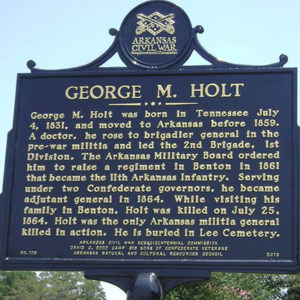calsfoundation@cals.org
George Moreau Holt (1831–1864)
George Moreau Holt played a prominent role in antebellum Arkansas as a physician, an Arkansas State Militia general, and a major in service to the Confederacy. He is also the only general officer of the Arkansas State Militia and its descendant organization, the Arkansas National Guard, to be killed in action by enemy forces.
George M. Holt was born on July 4, 1831, in Tipton County, Tennessee, the third son of six of Archibald Murphy Holt and Margaret Tilford Holt. His father, initially a engineer, later became a prominent physician in Bedford County, Tennessee. Holt and his brother Joseph followed in his footsteps by becoming physicians.
Little information is found to detail the early life of Holt except what is found on the 1840 and 1850 U.S. Census for Bedford County. At some point during the mid-1850s, he most likely attended the University of Nashville, which was close to his home and from which his younger brother Joseph graduated in 1858. The University of Nashville ran two educational institutions from 1855 to 1861: the Western Military Institute (modeled after the Virginia Military Institute) and the University of Nashville Medical Department. Holt was most likely a student of both, evidenced by his practicing medicine in Arkansas and his activities with the Arkansas State Militia.
At some point in the late 1850s, Holt migrated to Saline County, Arkansas, twenty-five miles southwest of Little Rock (Pulaski County), to begin his medical practice. In 1859, Holt married Harriet Moore. The couple resided next to her family, that of Colbert Moore, a Benton (Saline County) hotel keeper. Joseph Holt evidently migrated with him and, in 1860, resided with the George Elrod family in Hurricane Township of Saline County as a practicing physician.
During the years just prior to the Civil War, George Holt became active in the Arkansas State Militia. In 1860, he first served as colonel of the Eighteenth Regiment of Infantry before being promoted to brigadier general commanding the Second Brigade, First Division of the Arkansas Militia. As war erupted, Holt was tasked by the Arkansas Military Board to raise a regiment of infantry at Benton. On July 9, 1861, he enrolled seven companies at Benton, and with the addition of two more at Little Rock, it was designated as the Eleventh Arkansas Infantry. Holt did not attempt to join the unit he raised but remained in Arkansas as an active militia general.
In June 1862, as Garland’s Sixth Texas Infantry passed through Benton, an epidemic of measles erupted among them, and many had to be left behind. One of the few doctors left in the city, Holt was contracted to act as regimental surgeon until the sick could become well and be forwarded to their units. Holt was officially appointed a major in the Confederate army, serving for thirty days. After all the Texans left in Benton had either returned to their units or died, Holt’s rank as major was revoked. He simultaneously held rank as brigadier general in the Arkansas State Militia and major in the Confederate army. In 1864, Holt would serve the governor as adjutant general.
After the fall of Little Rock to Union forces in September 1863, the Benton area found itself in a “no man’s land” ravaged by both sides for provisions. Benton was garrisoned by Union troops temporarily in late 1863, and afterward numerous raids and scouting parties entered the town. The Union cavalry often stormed into town in hopes of capturing local soldiers visiting their families.
On July 25, 1864, a Union scout of the Third Missouri Cavalry (US) thundered into Benton while Holt was visiting his family. He rapidly mounted and attempted to make his escape on the Military Road (modern River St.) and across the Saline River. Private George Lucas of Company C gave chase, shot and killed Holt, and brought back his horse, equipment, and weapons. Holt’s wife and family recovered the body and buried him in Lee Cemetery, two miles east of town on the Military Road toward Little Rock.
For additional information:
Historical Files. Arkansas National Guard Museum. Camp Joseph T. Robinson, North Little Rock, Arkansas.
The War of the Rebellion: A Compilation of the Official Records of the Union and Confederate Armies. Series 1, Vol. 41, part 1. Washington DC: Government Printing Office, 1893.
Anthony Rushing
Benton, Arkansas
 Civil War through Reconstruction, 1861 through 1874
Civil War through Reconstruction, 1861 through 1874 Health and Medicine
Health and Medicine Military
Military George M. Holt Gravesite
George M. Holt Gravesite  George M. Holt Marker
George M. Holt Marker 




I learned George Holt’s story a few years ago while researching one of his siblings. Henry Clay Holt was the brother of George and Joseph Holt. He was younger and entered the U.S. Naval Academy in 1859. When the war began, the Naval Academy released the upperclassmen to go serve. Many returned to their homeland and joined the Confederate navy. Henry Holt was a midshipman in the CS navy and fought in a naval battle outside New Orleans and the first gunboat battle near Columbus, KY. After the loss of the river boats, Henry Holt joined the CS army and later was part of General James R. Chalmers’s Cavalry Division. He was placed in command of a small, mobile artillery: Buckner Battery. On October 11, 1863, General Chalmers attacked the Union fortification at Collierville, TN. In the middle of the battle General Sherman’s train arrived. Outnumbered 3,000 to 500, the Union troops were able to hold off the Confederates until relief arrived. Lt. Henry Holt had the best chance of getting General Sherman in his gun sights than anyone in the war. Lt. Henry Holt and several members of his family were buried at Manchester, TN.